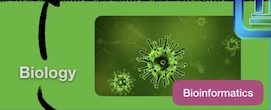Degree in Bioinformatics
Clickable infographics of university-level education in bioinformatics.


Career within the Academia
Many bioinformatics scientists work within academics, hospitals and government agencies
Academic titles:
- Professor
- Associate Professor
- Assistant Professor
- Acting Professor
- Lecturer
- Research Associate
- Research Fellow
- Junior Research Fellow
- Science Technician
- Research assistant
The labor market for bioinformatics scientists is global because technologies and concerns are similar or the same.
The rapid development in the biotechnology and related fields necessitate increased demand for bioinformatics scientists.
In the wake of the development of novel technologies also entails current competencies and life-long learning.
More on the future outlook for bioinformatics and data scientists, see our article at "Career Outlook: Data and Bioinformatics Scientists (2018-26)."


Career within the industry
A wide range of opportunies are within biotech companies, software companies, and companies specializing in bioinformatics applications.
Within the industry, job titles vary widely as well as job descriptions, that are company specific and depends on a particular HR department.
Here are some samples of possible titles:
- Scientist
- Research Scientist
- Principal Scientist
- Supervisor
- Manager
- Director
- Head of Bioinformatics
- Bioinformatics Specialist
- Bioinformatics Technician
- Bioinformatics Software Developer
- Software Developer
- Consult
The labor market for bioinformatics scientists is global because technologies and concerns are similar or the same.
The rapid development in the biotechnology and related fields necessitate increased demand for bioinformatics scientists.
In the wake of the development of novel technologies also entails current competencies and life-long learning.
More on the future outlook for bioinformatics and data scientists, see our article at "Career Outlook: Data and Bioinformatics Scientists (2018-26)."


Bioinformatics for both backgrounds
Usually consists of three semesters or about one and a half year.
Study outline:
- 1. Molecular evolution
- 2. Information management systems
- 3. Genome analysis
- 4. Large datasets for scientific applications
- Option: Degree project in bioinformatics for one year Master.
Second year Study outline:
- 1. Phylogenetic analysis
- 2. Population genetic analysis
- 3. Database design
- 4. Degree project in bioinformatics
Optional:
- 1. Literature project in bioinformatics
- 2. Research training
- 3. Project work in bioinformatics


Bioinformatics for biology background
Usually consists of one semester or about a half a year.
Study outline:
- 1. Introduction to bioinformatics
- 2. Introduction to Programming
- 3. Introduction to Scientific Computing and Statistics
- 4. Script programming
- 5. Database design
Bioinformatics for computer science background
Usually consists of one semester or about a half a year.
Study outline:
- 1. Introduction to bioinformatics
- 2. Introduction to molecular biology
- 3. Introduction to genetics and evolution
- 4. Script programming


Basic education in biology
Biology comprises everything from genetics, molecular biology, ecology, and environment.
During the first years, students learn essential biology knowledge, for example, cell biology, organism biology, microbiology, physiology, genetics, and ecology.
Depending on a specific direction, courses in anatomy, chemistry, anatomy, bacteriology, pharmacology, tissue biology, medical genetics, metabolism, biostatistics, and immunology may be relevant.
After the primary studies, students can choose to study a particular field in biology. For example, virology, molecular genetics, molecular biology, or nature conservation.
BSc in Biology requires a completed project work.
Basic education in computer science
These programs may last up to four years, depending on the institution and a specific program
Learning areas among others consist of programming, software architecture, mathematics, construction of computer systems, electronics, computer networks, distributed systems, signal processing.
Many physicists have also turned to bioinformatics scientists. They have studies material science, mathematics, chemistry, and many areas in physics, such as quantum mechanics, chemical bonds, and so on.


The descriptions loosely follow the study plans of Uppsala Universitet (Universitet=university in the Swedish Language).
Uppsala Universitet is one of the world's leading and oldest universities, located in a small town, Uppsala, about 70 km north of the capital Stockholm.
I can genuinely recommend Uppsala Universitet not only for the utmost quality education but also for the student environment and the student city's atmosphere and culture.
All the courses are in the English Language when even a single international student is present in a lecture. Furthermore, all course literature is in the English Language.
More information about the Master's in Bioinformatics, see Uppsala Universitet website.